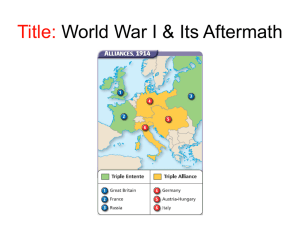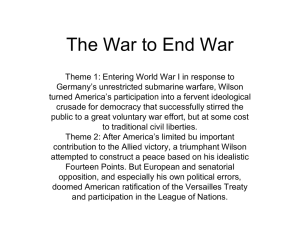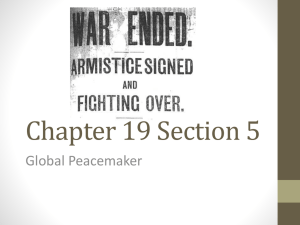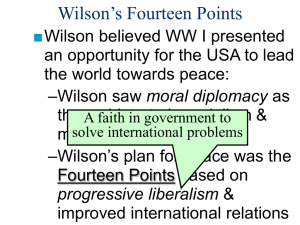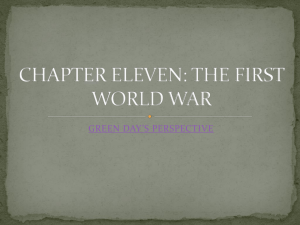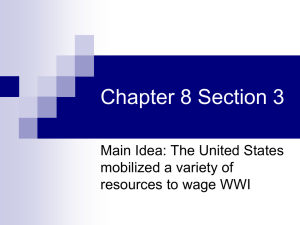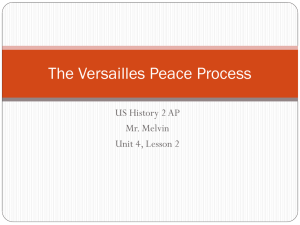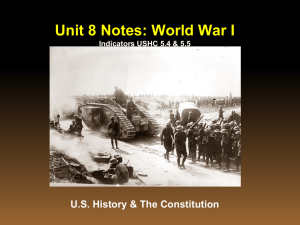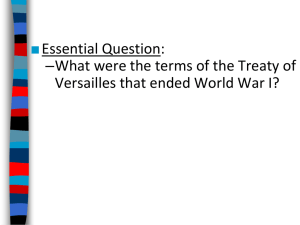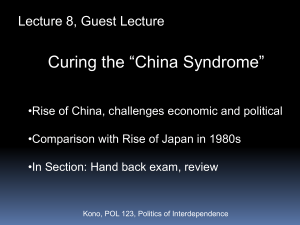US Pathway to Power part 1
advertisement
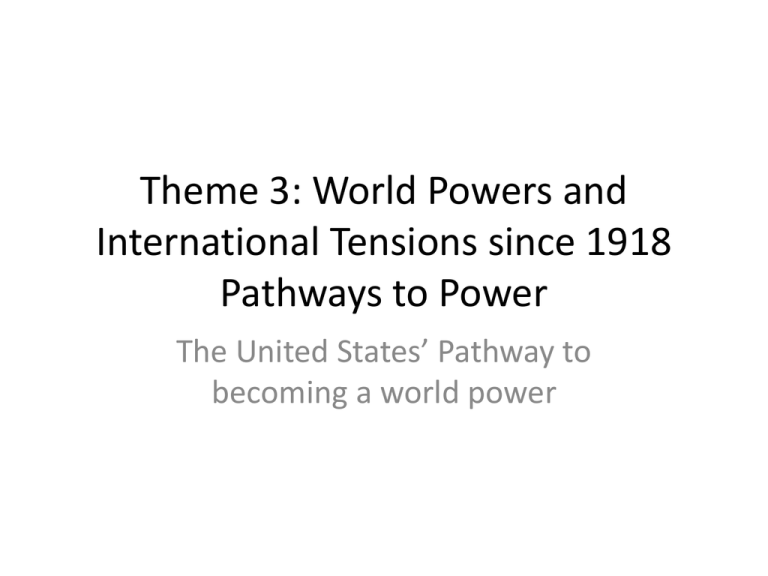
Theme 3: World Powers and International Tensions since 1918 Pathways to Power The United States’ Pathway to becoming a world power Key Questions • How has the notion of power been shaped and transformed by the United States in the twentieth century? • What military, political, ideological, economic and cultural factors have contributed to making the U.S. a world power? • Why did President Wilson’s project for the League of Nations fail? • How does the Second World War mark a turning point in U.S. foreign policy? Outline U.S. Pathway to Power • I. Different forms of power • II. 1918-45: From Isolationism to War • III. The Post-War World: The United States Disseminates its Power in a Bi-Polar World • IV. The United States in the World since the end of the Cold War: The Hyper-Power as World Police What is power? • Power, in the context of nations, can be defined as – the ability to do something (power), – to not do something (independence) and – to make others do something (influence or the faculty to impose one’s will on others). • The greater the influence, the broader the power; this is known as the “sphere of influence.” I. Different forms of power A. Diplomatic power (making treaties, agreements with other nations) B. Hard Power (military) C. Soft Power (cultural, monetary) A. Diplomatic Power • War-time conferences: –Atlantic Charter (August 1941) pivotal policy statement defining the Allied goals for the post-war world. drafted by the leaders of Britain and the United States (Roosevelt and Churchill), and later agreed to by all the Allies. Atlantic Charter stated the ideal goals of the war: – no territorial aggrandizement; – no territorial changes made against the wishes of the people; – restoration of self-government to those deprived of it; – free access to raw materials; – reduction of trade restrictions; – global cooperation to secure better economic and social conditions for all; – freedom from fear and want; – freedom of the seas; – and abandonment of the use of force, as well as disarmament of aggressor nations. Bretton Woods The Bretton Woods Conference, (July 1944) • 730 delegates from all 44 Allied nations in Bretton Woods, NH, USA • Opening speech by Franklin D. Roosevelt: “The economic health of every country is a proper matter of concern to all its neighbors, near and far." • Purpose: to regulate the international monetary and financial order after the conclusion of WWII Agreements at Bretton Woods • The GATT (General Agreement on Tariffs and Trade), inspired by the Atlantic Charter, was signed • Agreements were executed that later established the International Bank for Reconstruction and Development (IBRD, which is part of today's World Bank Group) for post-war reconstruction • International Monetary Fund (IMF). • Video:Bretton Woods System 0- '59 Bretton Woods • Seminal idea of open markets • End of economic nationalism • Stabilization of world currencies – Fixed the rate of all foreign currencies to the dollar – The dollar was backed by its value in gold • Major purpose was to avoid – World War III – The Great Depression II Power and Control of the IMF and the World Bank • Voting power based on economic power. • The 30 countries of the OECD (Organization for Economic Co-operation and Development) control almost twothirds of the votes in both the IMF (63.55%) and the World Bank (61.58%). • The G8 countries alone control almost half the votes (48.18% of the IMF, 45.71% of the Bank). Criticisms of IMF and World Bank • Neo-Liberal Approach – Conditionality – Structural Adjustment Programs • Dominated by Industrialized Countries – Voting system • Ethics of Projects – Human cost vs. Economic benefits Yalta Conference • February 4-11, 1945 near Yalta, in Crimea • WWII meeting of the heads of government of the U.S (FDR)., the UK (Churchill) and the USSR (Stalin) • Purpose: discussing Europe's post-war reorganization & re-establishment of the nations of war-torn Europe. • Within a few years, with the Cold War dividing the continent, Yalta became a subject of intense controversy Yalta Conference Decisions • Agree on free elections in Eastern Europe – Poland becomes a nation again (w/ new borders) • Agree to create the UN – Security Council (15 members w/ veto power including 5 permanent members U.S./USSR/China/Great Britain/France) • FDR convinces Stalin to go to war with Japan 90 days after the war in Europe is over Old and New Polish borders Potsdam Conference • July 1945, Stalin, Churchill (replaced midpoint by Attlee), and Harry S Truman, who had replaced the late President Roosevelt. • Treatment of Germany – US : rebuild – USSR: punish • Nuremberg Trials – High-ranking Nazis are tried Potsdam Conference • Partition of Germany – France is given part of Germany as long as it comes out of the Allies part • Berlin is also split into sectors – Germany gets split into 2 (east and west) • Truman informs Stalin of the atomic bomb in an effort to intimidate him Post-war occupation of Germany B. Hard Power • Definition: any means, mostly military and economic, which a nation disposes to make another nation act in a certain way, if necessary by force. The Atomic Bomb • Development and uses of the Atomic Bomb in final stages of WWII: Hiroshima and Nagasaki (only use of nuclear weapons to date) • Developed by physicist Oppenheimer; called The Manhattan Project • Japan refused to surrender after the Potsdam Declaration in July 1945 threatening prompt and utter destruction (Hitler had already surrendered) Debate over dropping atomic bombs • Supporters of the bombings generally assert they caused the Japanese surrender, preventing massive casualties on both sides in the planned invasion of Japan: Kyushu was to be invaded in October 1945 and Honshu five months later. It was thought Japan would not surrender unless there was an overwhelming demonstration of destructive capability. • Those who oppose the bombings argue it was simply an extension of the already fierce conventional air raids on Japan and, therefore, militarily unnecessary, inherently immoral, a war crime, or a form of state terrorism. At least one historian (Tsuyoshi Hasegawa) states that the Soviet declaration of war on Japan had more of an effect than the two nuclear bombings. Nuclear Diplomacy • Massive Retaliation under Eisenhower – Use of nuclear weapons as first strike option – Recognized limits to this policy • M.A.D. (mutual assured destruction) – is a doctrine of military strategy and national security policy in which a full-scale use of high-yield weapons of mass destruction by two opposing sides would cause the complete annihilation of both the attacker and the defender. – based on the theory of deterrence where the threat of using strong weapons against the enemy prevents the enemy's use of those same weapons. Economic Power Power of the Dollar since 1945 • Direct foreign investment 1946 % 1950 % 1964 % 1946 $M 1950 $M 1964 $M Canada 34.7 30.7 31.4 2.5 3.6 13.8 Latin America 43 38.9 20 3.1 4.6 8.9 Europe 13.8 14.4 27.3 1 1.7 12.1 Middle East and Africa 2.7 8.4 6.5 0.2 1.0 2.9 Rest of the World 5.8 7.6 14.8 0.4 0.9 6.6 Total 100 100 100 7.2 11.8 44.3 Evolution of the US dollar • 1945-1971 Dollar is the global currency • 1971-today Dollar is the new gold Standard – In essence the dollar is like the Gold Standard. Most global contracts, especially those for oil, are denominated in dollars. Many large economies, such as China, Hong Kong, Malaysia and Singapore, peg their currency to the dollar. When the dollar weakens, so do the profits of their exporters. These countries also hold large deposits of U.S. Treasuries, and could conceivably sell their holdings and cause a dollar collapse. However, it is not in their best interest. Monetary Difficulties of the US after the 1960’s 70 60 50 US gold reserves 40 30 theoretically convertible dollars in foreign countries 20 10 0 1949 1960 1965 Video: A Brief History of U.S. Money 1971 Videos: US Hard Power and War (ZINN) Joseph Nye on global power shifts (TED) C. American “Soft Power” Definition: Group of non-coercive means, mostly cultural or ideological which a nation disposes to make another nation think in the same way. Soft power is based on the power of conviction and not constraint US Cultural and Technological Power today II. 1918-45: From Isolationism to War A.) The attempt to impose a Peace Settlement Woodrow Wilson’s 14 points Wilson Video Points 1 - 7 • 1. Open covenants of peace • 2. Absolute freedom of navigation upon the sea, in peace and in war. • 3. The removal of all economic barriers and the establishment of an equality of trade conditions. • 4. Adequate guarantees given and taken that national armaments will be reduced to the lowest point consistent with domestic safety. • 5. A free, open minded, absolutely impartial adjustment of all colonial claims. • 6. The evacuation of all Russian territory and the cooperation, regarding Russia, of all nations of the world. • 7. Belgium to be evacuated and restored, without attempt to limit the sovereignty. Points 8 - 14 • 8. All French territory should be freed and the invaded portions restored. Alsace-Lorraine returned to France from Russia. • 9. A re-adjustment of the frontiers of Italy along clearly recognizable lines of nationality. • 10. The opportunity for the peoples of Austria-Hungary to become autonomous. • 11. Rumania, Serbia and Montenegro should be evacuated and the occupied territory restored. Serbia given free and secured access to the sea. • 12. Turkish portions of the Ottoman Empire given secure sovereignty. Other nationalities under that empire should be assured a secure way of life and opportunity of autonomous development. Dardanelles should be permanently opened under International guarantee. • 13. Independent Polish state should be erected, with free and secured access to the sea. • 14. General association of nations should be formed under specific covenants for the purpose of affording mutual guarantees of political independence and territorial integrity to all states (basically setting up 'the League of Nations'). The U.S. and post WWI • US only been in the war since April 1917. war damage and casualties not as high as France and Great Britain • Wilson’s ideas were influenced by his 14 points 2 main aims: – Self-Determination – International Co-operation (all working together) • Wilson did not want a harsh treaty for fear of Germany wanting revenge/another war... Paris Peace Conference • Delegates of 32 states attended PPC (none of defeated powers nor did Russia) • Main decisions made by Clemenceau of France , Wilson of USA and Lloyd Of Great Britain; All had different aims. • Published 14 points during war in Jan 1918; Germany not interested in principles by signing treaty of Brest-Litovsk with Russia; Russia forced to give up land to Germany and Austria-Hungary + pay war indemnity. • Gave Allies idea of how Germany would treat defeated nations if Germany won. • Only when Germany defeated; showed interest; claimed they believed they agreed to peace on basis of these points. Paris Peace Conference • Wilson; idealist; believed lasting peace not possible without new standards • Countries should be open + truthful; reorganize Europe's boundaries based on self-determination. • US: Only in war since 1917; Wilson didn't appreciate ill feeling towards Germany; simplified the problems. • His party was losing + growing feeling in USA; didn't want to be involved in European affairs. • No certainty that USA would sign Treaty. • Began agreeing with Clemenceau; put faith in success of League of Nations Henry Cabot Lodge • American Republican Senator and historian from Massachusetts. • He had the role (but not the title) of Senate Majority leader. • best known for his positions on foreign policy, especially his battle with President Woodrow Wilson in 1919 over the Treaty of Versailles. • Lodge demanded Congressional control of declarations of war; Wilson refused and the United States Senate never ratified the Treaty nor joined the League of Nations. League of Nations • Treaty of Versailles brought peace to Europe and set up League to preserve peace. • Left Germany with many grievances that contradicted peaceful 14 points. • If Germany ever recovered; determined to get rid of unfair clauses of Treaty; could lead to future problems • Wilson had put too much faith in power of League Of Nations to solve these problems and when US Congress refused to Sign Treaty and join the League settlement became less secure. Reading Assignments Part 1 (red = priority reading) • Mastering Modern World History by Norman Lowe (16 pgs) • • • • Part 1 War and International Relations 2. Peace settlement: 2.7-2.11, pp. 32-41 (read last year) 3. The League of Nations, pp. 43-49 (read last year) 4. International Relations, 1919-1933; United States Foreign Policy, pp. 66-67 • The Unfinished Nation by Alan Brinkley (13 pgs) • • • • • • Chapter 23: America and the Great War (read last year) The Search for a New World Order, p. 615-617 Chapter 27: The Global Crisis: The Diplomacy of the new Era, pp. 704-706 Isolationism and Internationalism, pp. 707-711 From Neutrality to Intervention pp. 712-717
